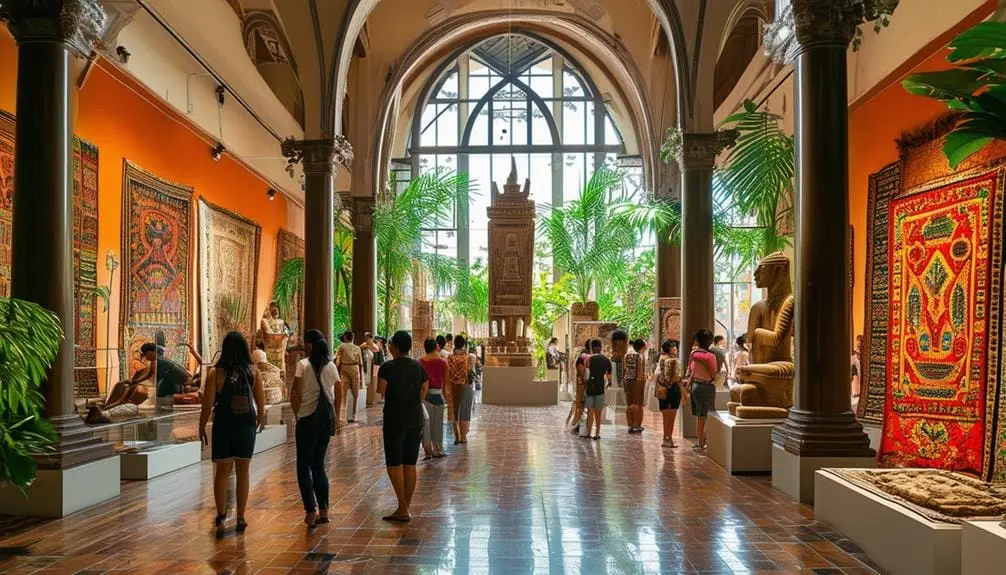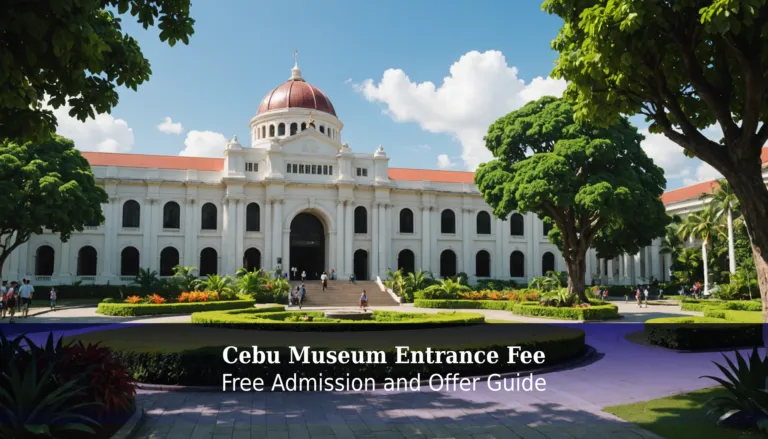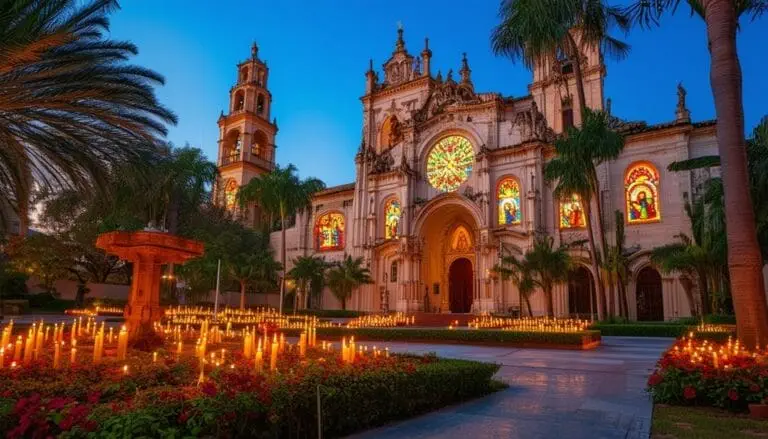Inside National Museum Philippines
When you step inside the National Museum of the Philippines, you're immediately greeted by a treasure trove of Filipino cultural heritage, from Juan Luna's iconic *Spoliarium* to a myriad of fine arts, anthropology, and natural history collections. You'll find interactive exhibits and educational programs designed to foster public appreciation and make cultural heritage accessible. But what truly sets this museum apart is its unwavering commitment to preserving and promoting Filipino identity. Curious about the vibrant narratives that await you within? Let's explore the National Fine Arts Collection and see what hidden gems lie in store.
Key Takeaways
- Juan Luna's *Spoliarium* is a notable highlight in the National Art Gallery.
- The museum features expansive collections of Filipino fine arts, anthropology, and natural history.
- Recently added Fernando Amorsolo's 1959 oil painting *Double Portrait of Nieves Balmori Gonzales de Moran and Her Daughter Nieves Moran Garcia*.
- Interactive exhibitions and educational programs engage visitors in Filipino cultural heritage.
- The National Museum of Fine Arts is part of the larger National Museum Complex in Manila.
National Fine Arts Collection
The National Fine Arts Collection stands as a tribute to the rich tapestry of Filipino artistry and cultural heritage. Recently, the collection was enriched by the addition of Fernando Amorsolo's 1959 oil painting, *Double Portrait of Nieves Balmori Gonzales de Moran and Her Daughter Nieves Moran Garcia*. This piece enhances the representation of Filipino artistry and highlights the National Museum's dedication to preserving and showcasing the nation's artistic heritage for future generations.
As you explore the collection, you'll discover significant works that reflect the unique cultural and historical narratives of the Philippines. Each piece within the national fine arts collection is meticulously curated to foster public appreciation and scholarly study of the contributions of Filipino artists throughout history.
The collection isn't just a static display but a vibrant reflection of the country's evolving identity and artistic legacy. Housed within the National Museum of Fine Arts, part of the National Museum Complex in Manila, the collection provides an immersive experience where you can connect deeply with the nation's cultural heritage.
Coastal Greenbelts Exhibition

While the National Fine Arts Collection celebrates the rich tapestry of Filipino artistry, the *Our Coastal Greenbelts, Our National Treasure* exhibition takes on a different but equally essential aspect of the nation's heritage.
Launched by Oceana on July 16 at the National Museum of Natural History, this exhibition raises awareness about the importance of coastal ecosystems. You'll find evocative photographic displays that underscore the urgency of environmental conservation, emphasizing the preservation of coastal resources.
This exhibition isn't just about passive viewing; it actively encourages you to engage with the community and participate in efforts to protect and maintain these crucial natural habitats.
Coastal greenbelts play a critical role in maintaining biodiversity and the overall health of marine ecosystems, acting as buffers against natural disasters and as nurseries for marine life.
Pride Month Celebrations

Celebrating inclusivity and diversity, the National Museum of the Philippines has embraced Pride Month with a series of vibrant and meaningful activities. By raising the Progress Flag at the NMP Complex, the museum honors its commitment to inclusivity and signals its unwavering support for the LGBTQ+ community. This symbolic gesture is more than a nod to Pride Month; it represents a year-round dedication to creating safe spaces for all identities.
Throughout June, museum employees participated in Colorful Fridays, an initiative aimed at promoting allyship. These themed Fridays fostered a spirit of unity and support among the staff, reinforcing the museum's inclusive culture.
Additionally, the facade of the National Museum of Fine Arts was illuminated with Pride colors, transforming the site into a beacon of diversity and acceptance. This visual celebration underlined the museum's mission to create a welcoming environment for everyone.
More than just festivities, these activities aimed to deepen awareness and appreciation of the LGBTQ+ community within the context of Filipino heritage and culture. By intertwining these elements, the museum not only celebrates diversity but also educates the public, fostering an inclusive atmosphere that respects and honors all aspects of Filipino heritage.
Restoration of Cultural Heritage

You can't overlook the significance of the Archdiocesan Shrine of Our Lady of Caysasay's reopening on June 20, 2023, marking a milestone in the National Museum's restoration efforts.
This initiative not only preserves an essential piece of Filipino heritage but also boosts cultural tourism in Taal, Batangas, drawing visitors keen to explore its historical roots.
Historical Site Reopenings
The recent reopening of the Archdiocesan Shrine of Our Lady of Caysasay on June 20 stands as a tribute to the Philippines' unwavering dedication to preserving its cultural heritage.
This significant event underscores the country's commitment to restoring and maintaining its historical sites, which are rich in cultural artifacts and historical importance.
The restoration of the shrine wasn't just about physical repairs; it was a meticulous process aimed at reviving the historical essence of the landmark.
The collaborative efforts between the National Museum, the Archdiocese of Lipa, and the Taal community highlight the collective responsibility in safeguarding these treasures.
By reopening the shrine, several key objectives are achieved:
- Preservation of cultural heritage: Ensuring that future generations can experience and learn from these historical sites.
- Restoration of historical artifacts: Bringing back the original splendor of invaluable items within the shrine.
- Community engagement: Empowering local communities to take pride and active roles in heritage conservation.
- Promotion of historical education: Providing an authentic context for learning about the nation's past.
- Increased cultural awareness: Encouraging a deeper appreciation of Filipino history and heritage.
In essence, the reopening of the Archdiocesan Shrine of Our Lady of Caysasay is a reflection of the Philippines' ongoing efforts to honor and preserve its rich cultural tapestry.
Cultural Tourism Boost
Highlighting the National Museum's dedication to cultural preservation, the recent restoration of the Archdiocesan Shrine of Our Lady of Caysasay underscores a strategic effort to boost cultural tourism in the Philippines. The shrine, which reopened on June 20, 2023, is a demonstration of the commitment to safeguarding Filipino heritage.
By restoring this historical site, the National Museum not only preserves an essential piece of the nation's cultural heritage but also attracts both local and international tourists keen to experience authentic cultural and historical landmarks.
This restoration project is part of a broader initiative to promote awareness and appreciation of Filipino history and culture. Restoring and maintaining such sites fosters a sense of pride and ownership among local residents, thereby engaging the community and encouraging tourism-related economic activities.
As tourists flock to these rejuvenated sites, they contribute to the local economy, creating a sustainable model of cultural tourism.
The National Museum's efforts align perfectly with its mandate to preserve and protect cultural properties. By reinforcing its role in promoting cultural tourism, it guarantees that Filipino heritage is celebrated and recognized, both locally and globally, while empowering communities and enhancing economic growth.
Museum Overview

You'll find that the National Museum of the Philippines, established in 1901, aims to preserve and promote Filipino cultural heritage.
With distinguished collections ranging from Juan Luna's *Spoliarium* to significant anthropological artifacts, the museum highlights key aspects of the nation's history and identity.
Mission and Objectives
As a premier custodian of the nation's cultural and natural heritage, the National Museum of the Philippines is dedicated to acquiring, documenting, preserving, and exhibiting cultural artifacts that embody the rich history and diverse heritage of the Filipino people.
The museum's mission goes beyond mere preservation; it aims to foster scholarly study and public appreciation of the Philippines' unique cultural heritage and natural history.
To achieve these goals, the National Museum emphasizes several key objectives:
- Fostering Scholarly Study: Encouraging research that deepens understanding of the Philippines' cultural and natural wealth.
- Enhancing Public Appreciation: Offering educational programs and exhibitions that make cultural heritage accessible and engaging to all.
- Promoting Cultural Understanding: Implementing outreach initiatives that bring the museum's offerings to diverse audiences across the nation.
- Developing Local Cultural Awareness: Operating regional sites to guarantee that local communities actively participate in preserving their heritage.
- Enforcing Cultural Laws: Implementing regulations to protect and promote the Philippines' artistic and historical legacy.
Key Collections Overview
Building upon its mission to foster scholarly study and public appreciation, the National Museum of the Philippines offers an expansive array of collections that span from the earliest periods of Philippine history to contemporary works of art.
When you explore these collections, you'll experience a vibrant tapestry of the Philippines' rich cultural heritage.
The National Art Gallery stands out with Juan Luna's renowned painting, *Spoliarium*, a masterpiece that captures the nation's complex historical and emotional landscape.
But don't stop there—delve into other fine arts sections showcasing works from various periods. Each piece tells a unique story of the Filipino spirit and artistic evolution.
Anthropology and archaeology collections provide a window into the daily lives and traditions of early Filipinos. You'll find artifacts that reveal the Philippines' ancient civilizations and their sophisticated craftsmanship.
The natural history exhibits, on the other hand, celebrate the archipelago's biodiversity, highlighting endemic species and ecological narratives.
Specialized galleries, like the one dedicated to national hero Jose Rizal, offer an in-depth look at pivotal figures and moments in Philippine history.
With free admission on Sundays, the museum guarantees that these cultural treasures are accessible, inviting everyone to engage with and appreciate the nation's heritage.
Collections and Research

The National Museum of the Philippines stands as a guardian of the nation's cultural and natural heritage, meticulously curating extensive collections that span fine arts, anthropology, and archaeology. Its role goes beyond mere preservation; it's a dynamic hub where cultural heritage and biodiversity converge through rigorous research programs.
You'll find that the museum's natural history collections, which include botany, zoology, geology, and paleontology, are essential for understanding the Philippines' rich biodiversity.
To keep you engaged, consider these highlights:
- Extensive fine arts collections: Showcasing the evolution of Filipino artistry.
- Anthropological treasures: Offering insights into human origins and prehistoric life.
- Biodiversity research: Enriching knowledge about the Philippines' unique ecosystems.
- Maritime heritage studies: revealing the seafaring history of the archipelago.
- Ethnological artifacts: Preserving the diverse cultural practices of various Filipino ethnic groups.
The museum's permanent research programs aren't just academic exercises; they actively contribute to public education and scholarly knowledge.
Their findings are shared through exhibitions, publications, and community engagement initiatives. This approach not only preserves cultural artifacts but also makes them accessible, fostering a deeper appreciation of Filipino heritage.
You'll find the balance of conservation and education here both liberating and enlightening.
Visitor Information

While the National Museum of the Philippines excels in preserving and showcasing the nation's cultural and natural heritage, it also prioritizes accessibility and visitor engagement.
You'll find the museum open from Tuesday to Sunday, between 10:00 AM and 5:00 PM, making it convenient for both local and international guests. Admission fees are quite reasonable – PHP 50 for students, PHP 120 for senior citizens, and PHP 150 for adults. However, if you visit on a Sunday, you'll enjoy free entry.
Located at Padre Burgos Drive, Rizal Park, Manila, the museum is easily accessible, which makes it a perfect destination for an educational outing. Located at Padre Burgos Drive, Rizal Park, Manila, the museum is easily accessible, which makes it a perfect destination for an educational outing. Visitors can explore its fascinating exhibits that showcase the rich history, art, and culture of the Philippines. For those interested in a more immersive historical experience, a Fort San Pedro Museum tour is a great complement to their visit, offering deeper insights into the country’s colonial past.
The museum's focus on public engagement is evident through its diverse exhibitions and outreach programs designed to cultivate a deeper appreciation for Philippine art and cultural heritage.
If you have questions or need more visitor information, you can contact the museum directly by phone at +63 (02) 527-1215 or via email at education@nationalmuseum.gov.ph.
This commitment to accessibility guarantees that you can plan your visit comfortably and make the most out of your experience at the National Museum of the Philippines.
Frequently Asked Questions
What Is Inside the National Museum of the Philippines?
You'll find art collections, historical artifacts, and cultural exhibits that reveal the rich tapestry of Filipino heritage. Explore fine arts, anthropology, and natural history. Each museum offers a unique perspective, inviting you to investigate deeper into the nation's past.
Can You Take Pictures Inside the National Museum of the Philippines?
You can take pictures, but follow the photography rules to respect cultural preservation. Avoid flash and tripods, check for signage, and practice good museum etiquette to guarantee everyone enjoys their visit without disruptions.
Is National Museum Philippines Free Entrance?
Yes, the museum offers free entrance every Sunday, enhancing accessibility. This policy boosts public engagement with Filipino culture and history, enriching your visitor experience and highlighting the museum's cultural significance and commitment to inclusivity.
How Long Does It Take to Go Around National Museum Philippines?
You can explore the museum in about 2 to 4 hours. For exhibit highlights, consider guided tours. Visitor tips: arrive early and plan your visit on a Sunday for free admission, maximizing your experience.
Conclusion
You've explored the National Museum of the Philippines, examining its vast collections and dynamic exhibitions. From the celebrated *Spoliarium* to vibrant Pride Month celebrations and essential restoration efforts, the museum offers an extensive glimpse into Filipino heritage. Its commitment to education and engagement guarantees every visit is enriching. Don't miss the chance to immerse yourself in this cultural treasure trove, where history and art come alive, fostering a deeper appreciation of the nation's diverse identity.







